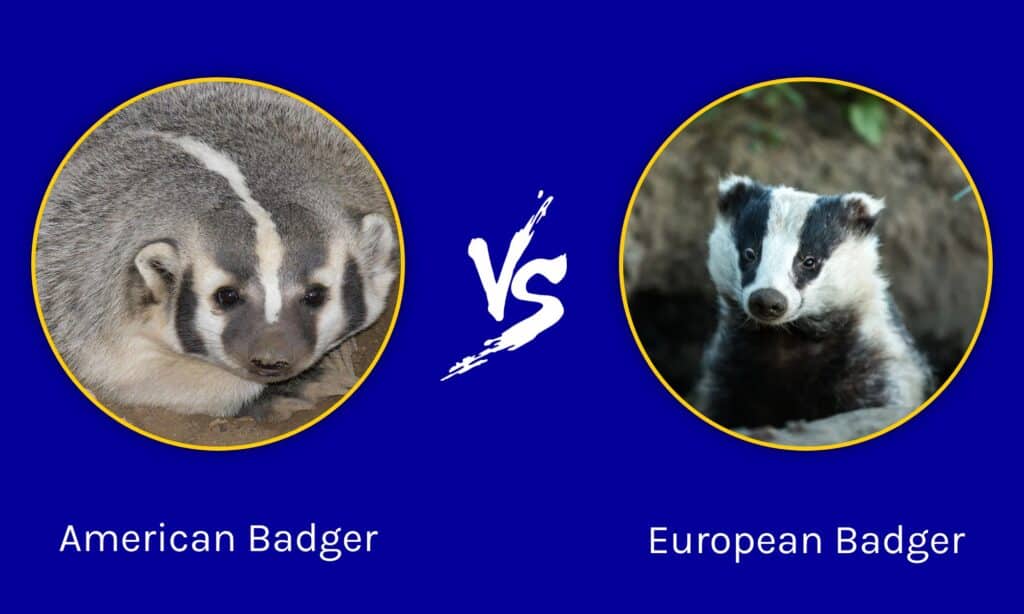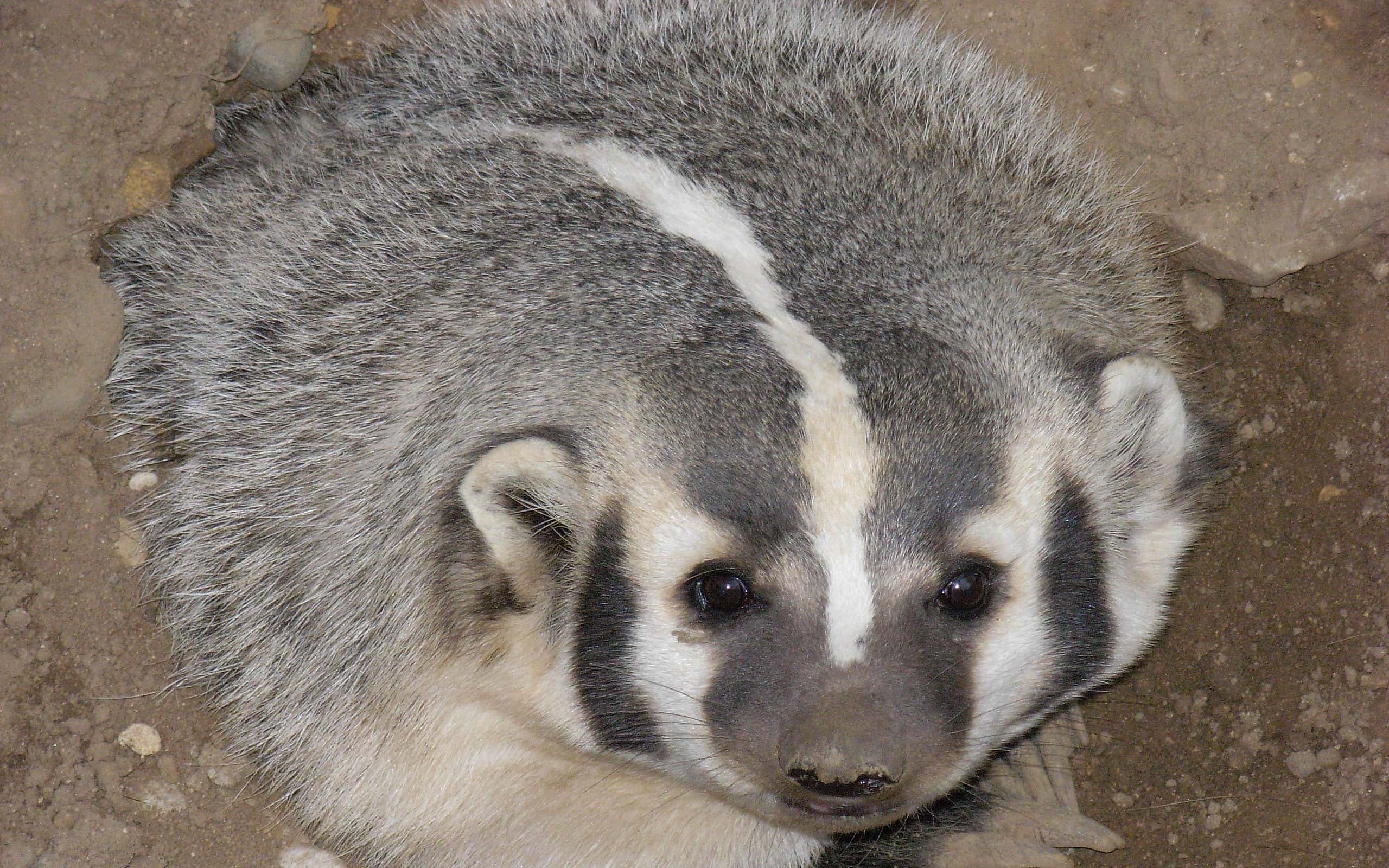Did you know that there are many key differences between an American badger vs European badger? While both of these animals belong to the same family, there are some key differences in their species based on their geographical locations. But what might some of these differences be?
In this article, we will compare and contrast all of the similarities and differences between the American badger and the European badger. We will go over their physical descriptions in detail so that you can learn how to tell them apart, even though it isn’t easy! We will also discuss their dietary and behavioral preferences. Let’s get started and learn all about badgers now!
Comparing American Badger vs European Badger

| American Badger | European Badger | |
|---|---|---|
| Size | 20-30 inches long; 20-30 pounds | 25-45 inches long; 20-40 pounds |
| Appearance | Brown, gray, and white coarse fur with distinct white and black stripes on face. White stripe goes from base of nose to base of tail frequently, and tail is bushy | Black and white fur with smoother coat; clear and straight lines on face and around eyes. Short and stubby tail with little fur; short legs and powerful clawed feet. Rounded or wedge shaped body |
| Diet | Carnivore; gophers, squirrels, rattlesnakes, and birds | Primarily omnivorous; earthworms, insects, grains, and small mammals |
| Behavior | Nocturnal unless in remote areas; powerful digger and generally more solitary than other species. Frequently hunts with coyotes | Digs complicated dens and burrows with their familial group; one of the most social badger species. Depending on location, hibernation may occur |
| Location | United States, Canada, and Mexico; grassland regions with soft soil | Throughout Europe; prefers woodlands and even suburban parks |
Key Differences Between American Badger vs European Badger

The American badger is primarily carnivorous, while the European badger is primarily omnivorous.
©Michal Ninger/Shutterstock.com
There are many key differences between an American badger and a European badger. The European badger is larger than the American badger on average, both in length and weight. The American badger is primarily carnivorous, while the European badger is primarily omnivorous. Finally, the European badger is considered one of the more social of the badger species, while American badgers enjoy solitary lifestyles.
Let’s discuss all of these differences in more detail now.
American Badger vs European Badger: Size
One of the main differences between the American badger and the European badger is their size differences. The European badger is larger than the American badger, in a few different ways. For example, the American badger reaches 20 to 30 inches in length on average, while the European badger reaches 25 to 45 inches in length.
This also means that the European badger outweighs the American badger. Depending on the season, the European badger weighs anywhere from 20 to 40 pounds, while the American badger weighs 20 to 30 pounds on average. Both badger species weigh more in the fall than in the spring, as they prepare for winter.

Depending on the season, the European badger weighs anywhere from 20 to 40 pounds, while the American badger weighs 20 to 30 pounds on average.
©Gary M. Stolz, U.S. Fish and Wildlife Service, Public domain, via Wikimedia Commons – License
American Badger vs European Badger: Diet
While all badger species are omnivorous or primarily carnivorous, there are some dietary differences between the American badger and the European badger. For example, the European badger is an outlier in the badger family, given that it is primarily omnivorous, while the American badger is a carnivore and rarely eats plant matter. Let’s talk more about what they eat now.
The American badger eats gophers, squirrels, rattlesnakes, and birds, while the European badger eats earthworms, other insects, and grains as its primary source of food. However, even the European badger occasionally eats small mammals and birds, though it prefers insects and plant matter.
American Badger vs European Badger: Appearance

The American badger’s fur has more brown and gray in it compared to the black and white coat of the European badger.
©Martin Mecnarowski/Shutterstock.com
It can be very difficult to tell an American badger apart from the European badger at first glance. However, there are some similarities and differences that you can keep an eye out for in order to identify them from one another. Let’s talk about their physical description and appearance in more detail now.
The American badger’s fur has more brown and gray in it compared to the black and white coat of the European badger. You may also notice that the European badger’s face has distinct and clear lines in black and white on it, while the American badger has a more uneven line of white from the center of its face all the way down its back and to the base of its tail.
However, it is difficult to tell these two types of badgers apart otherwise. They both have stocky and strong legs, as well as rounded or wedge-shaped bodies. They have short tails, but it appears as if the American badger’s tail is bushier than the European badger’s tail. Plus, both of these species have powerful claws for digging their complicated homes underground.
American Badger vs European Badger: Behavior

Depending on the geographical location of the European badger, some badgers may hibernate, while American badgers do not do this.
©Jonathunder, CC BY-SA 3.0, via Wikimedia Commons – License
There are few differences in the behaviors of the American badger vs the European badger. For example, the American badger is primarily solitary, while the European badger enjoys complex social groups. Depending on the geographical location of the European badger, some badgers may hibernate, while American badgers do not do this.
An interesting fact about the American badger is that it frequently hunts alongside coyotes, while European badgers do not do this. However, European badgers are often considered as invasive or overpopulated as foxes in Europe, which typically gets them into trouble.
American Badger vs European Badger: Location and Habitat
The final difference between the American badger and the European badger is their location and habitat preferences. You may have already guessed this, but the European Badger is found throughout Europe, while the American badger is found in the United States, Canada, and parts of Mexico.
The photo featured at the top of this post is © Coatesy/Shutterstock.com
Thank you for reading! Have some feedback for us? Contact the AZ Animals editorial team.







